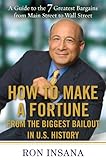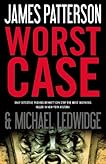 The blurb:
The blurb:There is a well-worn saying on Wall Street that the time to buy is when there is "blood in the streets." There has been no time in modern economic history when more "blood" has been spilled on the streets of now infamous financial capitals - but from such chaos always arises opportunity.
In
How to Make a Fortune from the Biggest Bailout in U.S. History, financial expert, author, and CNBC senior analyst Ron Insana shows you how to make the most of the current economy. While teaching you how to protect yourself from the hyperinflation that may hit, Insana helps you:
- Find up-to-the-minute resources to hit the jackpot
- Identify which stocks to look for and how to buy low - really low - and sell high
- Cash in on distressed credit
- Understand why you should take TIPS (Treasury Inflated Protected Securities) from Uncle Sam
- Take the right risks in sifting through junk bonds
- Learn why, where, and how to jump on the property wagon
- Tap into the right fed programs for big rewards
More important, Insana shows how the pros put together a balanced portfolio of deep-value stocks, government-backed bonds, distressed debt, and the now hidden, but solid, values in real estate, using the actual assets or some very effective proxies, like Exchange Traded Funds (ETFs) and other tax-efficient and inexpensive mutual funds.
Bringing together the investment acumen he developed as an active participant in one of Wall Street's wildest periods and the unique perspective that comes from being an active and accurate observer of financial market history for the last twenty-five years, Insana will teach you how to take back your lost money and make the most of it-by doubling, tripling or quadrupling your fortune!
Review:How to Make a Fortune from the Biggest Bailout in U.S. History is divided into seven parts:
- The Sub-Prime Primer
- Don't Look Back! (Well, Look Back a Little)
- Dressed for Distress
- Wall Street in Distress
- A Crisis in Credit
- Homes, Suites, Homes
- The Really Big Bailout
Insana starts by briefly explaining how this current recession fits in the U.S.'s economic history, then describes how people like Warren Buffett and Sam Zell use these difficult times to scout for value opportunities. Insana then points out that Uncle Sam's present help is creating unique opportunities at this time through the"drop in interest rates, government support programs or assistance to buy both old and new assets."
Insana organizes a resource guide at the start of the book to help readers prepare for and research investment opportunities. The guide includes: (1) financial news websites like CNBC.com and TheStreet.com; (2) the basic array of periodicals, like
The Wall Street Journal, The New York Times, The Financial Times, The Washington Post, and
The Drudge Report; (3) research services like Morningstar; (4) sites specific to real estate and foreclosure opportunities; and (5) helpful sites provided by a wide range of government agencies and institutions.
Insana urges the consumer/"average investor" to recognize that while the average investor's response to this decline in stock and asset prices is to run from the decline, a rational and professional investor would recognize that "America is on sale" and look around to identify bargains. Insana claims that "many asset classes remain 40 to 50 percent below their all-time highs." Insana points out how the average investor behaves differently when buying on Main Street versus on Wall Street: she hurries to drops in prices of electronics or home goods but when investing, she usually buys when the prices rise instead of when they dip.
Insana warns that as inflation accelerates the value of cash will be reduced considerably and recommends that investors explore investing in stocks, Treasury Inflation-Protected Securities (TIPS), municipal bonds, and new federal bonds ("Obama Bonds"). To help the average investor evaluate stocks, Insana compares the current "Great Recession" to the Great Depression and points out areas of risk. He includes clear explanations of investment concepts such as dollar cost averaging and "buying the market" through choosing proxies for market averages through index funds and ETFs (exchange-traded funds) by way of explaining how an average investor might invest without having to select specific stocks. Insana explains the concept behind TIPS, which are Treasury bonds that pay a nominal yield and a premium for rising inflation. Since interest rates are at historic lows, Insana points out that they can only be expected to rise, but the TIPS protect the investor from the risk of inflation.
In
Homes, Suites, Homes, Insana delves into his family's experience with homeownership and makes the point that a home is not necessarily an investment but it is likely to be the largest single purchase that an investor will make. Insana also recommends against taking out home equity lines of credit and instead suggests several ways to avoid having to rely on a second mortgage or a home equity line of credit. Insana offers specific suggestions for purchasing distressed real estate, whether through an actual house, whether out of foreclosure or through a short sale or from the owner directly, or through investment in real estate investment trusts (REITS) or other funds that buy residential real estate.
It is in
The Really Big Bailout: TAF, TARP, TALF, PDCF, AMLF, CPFF, MMIFF, and PPIP, that Insana gives an overview of the new programs that the Federal Reserve and the U.S. Treasury have put into place to absorb the enormous amounts of bad debt held by U.S. financial institutions. Isana clearly supports the "lifeline" extended to these critically important financial institutions, but he points out that several of these programs, such as the TALF and PPIP, will also benefit individual investors directly. Instead of going into the details, he steers the average investor to websites that can serve as starting points for investment research.
Overall, in
How to Make a Fortune from the Biggest Bailout in U.S. History, Ron Insana recommends areas for investment in an upbeat and straightforward manner. He suggests where an average investor might research investment opportunities based on her tolerance for risk, time horizon, asset mix and interest. I found the sections on the federal bailout programs, TIPS, municipal bonds, and Obama Bonds particularly interesting and potentially useful. If you're looking for an overview of the investment opportunities available during this "Great Recession" or if you want to make sure that you're properly tending to your money, I recommend giving Ron Insana's latest book a read.
ISBN-10: 1583333649
Publisher: Avery (December 31, 2009), 224 pages.
Review copy provided by TLC Book Tours.About the Author, courtesy of CNBC:
Ron Insana is CNBC’s senior analyst and commentator giving his perspective on important business stories. He also appears on
Squawk Box once a month. Previously, Insana was the anchor of CNBC's
Street Signs.
Insana began his career in 1984 as an FNN production assistant, rising to managing editor and chief of FNN's Los Angeles bureau at the time the two networks combined. While at FNN, he was nominated for a Golden ACE Award for his role in covering the 1987 stock market crash.
Trendwatching: Don't be Fooled by the Next Investment Fad, Mania, or Bubble, his third book, was published by Harpers Business in November, 2002. His first book,
Traders' Tales (John Wiley), a compendium of anecdotes about Wall Street Life, was published in 1996. His second book,
The Message of the Markets, was published by Harpers Business in October 2000.
Insana was nominated for a News and Documentary Emmy Award as part of NBC’s coverage of 9/11, and in 1999, Insana was named one of the top 100 business news journalists of the century by TJFR Group.
Learn more at Ron Insana's website at www.howtomakeafortune.com
 Thank you so much to Ron Insana, Lisa and TLC Book Tours for this review opportunity!
Thank you so much to Ron Insana, Lisa and TLC Book Tours for this review opportunity!











